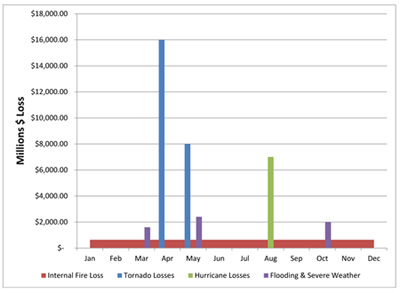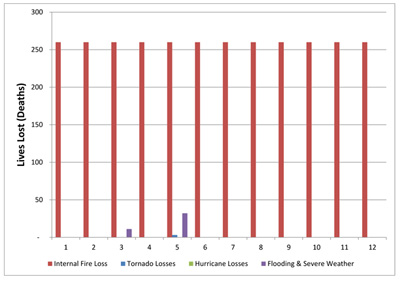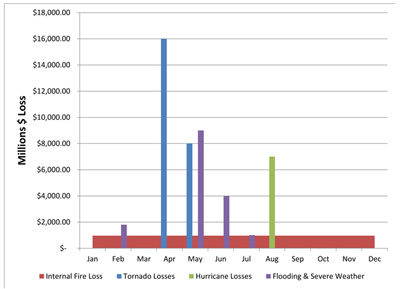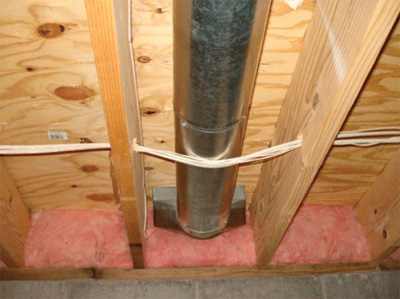Living in a silo can limit your success and the success of safety in our industry — the activity of breaking down silos and building healthy bridges can elevate and strengthen your safety message. Every year, and pretty much each month, there is a state somewhere that is either reviewing or actively meeting to adopt a building code. We in the electrical industry are called to action every now and then in various states that decide adoption of the latest National Electrical Code without amendment is just not an option.

Figure 1. 2010 losses in the United States in millions of dollars. The internal fire band is persistent on a month-by-month basis, whereas the natural disaster statistics are dependent on the time of year.
But we’re not the only industry that faces this type of challenge, and at times we may find ourselves drawn into reaction mode due to suggested changes to the electrical code based on negotiations taking place in the adoption of what may appear to be unrelated code legislation. The following was taken from a press release out of Missouri in March of 2010: “Missouri needs to show that we have a plan in place to enforce and honestly assess our compliance rates with the national model energy building codes. But first Governor Nixon must ensure that we adopt the 2009 IECC codes statewide and we must have a process to update them. The $28.6 million that we should receive as additional SEP funds may depend on that adoption.”1
Conditions placed on the distribution of funds stimulate activity around code adoptions, but if not watched closely, these conditions could stimulate the wrong types of activities. In at least one state where new energy codes were being adopted, other non-related codes where jeopardized during adoption negotiations. The fact is that codes and standards work together in our markets to increase safety and efficiency- and compromise of any of these is not real progress. We need to break down the silos in our effort to support safety — rest assured that once negotiations begin, your opponent will break down the silos for you in a way you hadn’t expected.
The Bigger Picture

Figure 2. 2010 losses in the United States in terms of lives/deaths. Internal fires are persistent month-to-month, whereas the natural disaster statistics are dependent on the time of year.
All codes that a state reviews and adopts work together to make a resilient state — resilient to not only electrical problems but many other issues that may be brought on by nature or others that cost our country lives and property. Reducing any one code may weaken the “system,” as a home or other structure is really a compilation of products and design solutions working together as a system. We as inspectors or installers or manufacturers of electrical equipment are very focused on electrical codes and standards but we have to keep our perspective that we are one part of the entire system.
Sometimes it helps to “pop up a level,” so to speak, and see the big picture. One way to do this is to look at loss in the United States, numbers that are published that tell the big picture that include more than just the markets in which we live and work. There are many conditions that cost our country lives and property and in many ways are good examples of why building codes work together to ensure the structure, in its entirety, is safe and resilient to what Mother Nature and the world of do-it-yourselfers can throw at it. Let’s look at the years 2010 and 2011 as examples to help convey what we’re talking about.
For simplicity sake, the statistics we’ll focus on here include Internal Home Fires, Tornados, Hurricanes and Flooding/Severe Weather as a start. These are some key areas that organizations follow closely and document the low-hanging fruit, as some may call it, from a data perspective. This low-hanging fruit can be quite telling, even though we are looking at natural disaster statistics — all of these perils impact the integrity of a structure. Hopefully the structure was built to a code that was not modified during its adoption. We could probably make a good argument that building above a bare minimum code is actually where our country needs to be to really impact some of the statistics of loss of life and property. Some call this Code Plus.

Figure 3. 2011 losses in the United States in millions of dollars. The internal fire band is persistent on a month-by-month basis, whereas the natural disaster statistics are dependent on the time of year.
It’s obviously quite expensive and difficult to build a structure that withstands a direct hit from a tornado or a category 4 hurricane, but we have to remember all of those other homes that aren’t directly in the path of the hurricane or tornado that will experience the high winds, water and other conditions with which these natural events surround themselves.
The National Oceanic and Atmospheric Administration (NOAA) tracks and reports on hurricanes and other natural disasters. This organization published a report entitled “Billion Dollar U.S. Weather/Climate Disasters, 1980–September 2011” which documents the major events that occurred in the United States over that time period. For the year 2010, this reference documents the fact that tornados and flooding/severe weather cost our country over $9 billion and 46 lives. Hurricanes were not documented as 2010’s hurricanes in the United States did not show any single event to be as devastating as some of the tornado and flooding issues that we experienced. In the Atlantic alone, NOAA reports that there were 12 hurricanes, but upon reading the details of these events, their U. S. landfall did not prove to be destructive enough to make the Billion Dollar Disaster reports. Rest assured, the damage from these were in the millions.
The National Fire Protection Association (NFPA) reports that for this same year U. S. fire departments responded to more than 1 million fires which resulted in 3,120 civilian fatalities, 17,720 civilian injuries and more than $11 billion in direct property loss. In essence, a civilian died due to fire every 169 minutes and was injured every 30 minutes in 2010.2 Figure 1 illustrates, in a financial way, loss from internal fires, tornados, hurricanes and flooding/severe weather for the year 2010. Figure 2 illustrates loss of lives for this same time period and same catastrophic events. These numbers and statistics are staggering. Figures 1 and 2 go beyond the billion dollar NOAA report in an attempt to capture an expanded picture of loss.

Figure 4. 2011 losses in the United States in terms of lives/deaths. Internal fires are persistent month-to-month, whereas the natural disaster statistics are dependent on the time of year.
The year 2011, on the other hand, shows a little different picture from the natural disaster perspective as good ole Mother Nature is not always consistent. NOAA reports that for 2011, natural disasters (hurricanes, tornados, flooding and severe weather) caused $46.8 billion in damage, 633 deaths and 3,533 injuries. In actuality that number is probably a little larger as again we’re looking at a report that is entitled “Billion Dollar . . . Disasters” and there are other nickle and dime events that add up and took lives which are not accounted for here. If we assume similar losses for internal fires that we used in 2010, figures 3 and 4 depict the losses in dollars and lives for 2011.
These numbers are staggering when you really sit back and look at them. We’re talking about more than $20 billion dollars in losses for 2010 and upwards of $60 billion dollars in losses, all combined, for 2011. These numbers are indeed very big but the numbers that strike my nerve more so is that more than 3,100 and 3,700 lives were lost in 2010 and 2011 respectively, due to these disasters, and we’ll probably experience similar numbers in the years to come.
Codes and Standards — The System
As was stated earlier, our construction codes are not silos and cannot be treated as such, for they work together as a system to improve the safety of the structure in its entirety. If construction codes were not treated as a system and some portions were modified or removed completely, the results would not be very attractive. As an example, if we built a home that could withstand a direct hit from a tornado or a category 4 hurricane, or even both at the same time, but yet reduced or removed other essential safety codes, we could still have loss of life, in that same home, due to carbon monoxide poisoning, electrocution or other events because those other important codes were not employed or were modified. Our wires are protected by the infrastructure that encases them. This includes the joists and trusses and other physical construction members that are put in place as per construction codes. If that infrastructure is not built to code, is weak or is misapplied, damage to wires could occur that may have devastating results.

Photo 1. Wires that were pulled by HVAC installers so as to get duct work to pass between the wires and the floor.
Awareness of your surroundings is really at the heart of codes and standards as a system. This holds true for many aspects of construction. Take, for instance, the example of a new home being constructed where many trades will have to peform work within the structure. Getting the order incorrect of when each trade performs work in the structure could jeopardize the integrity / safety of the structure.
One example that has graced these pages in the past is from my home that I had built a few years back. In my case, my electrician was installing wire and receptacles before the plumbing and HVAC trades had their equipment installed. This lead to the pulling and jerking of wires to get pipes and duct work installed (see photo 1). This also resulted in the soldering of copper water lines in and around installed wires. My duct work had to be cut for water lines and the integrity of the HVAC system was compromised and is not as efficient as it could be (see photo 2).
Everything in a home works together in concert and is a great example of why we obviously cannot live in a shell thinking that the home or any structure and the codes and standards that govern their construction in its entirety are not systems.
Aligning with Government Goals
The Department of Homeland Security (DHS) has recently made changes to their mission statement that will hopefully have an impact on safety across the United States. Presidential Directive 8 on National Preparedness spurred the DHS to review their mission statement and make a change. For the first time, mitigation is included in their mission statement.
Mr. William Fugate, administrator of the Federal Emergency Management Agency (FEMA), recently spoke at an event where he noted that building codes, their adoption, and, yes, their enforcement are critical to our country’s ability to respond to or to mitigate disasters. He made a point to note that disasters are not just limited to wind and water; disasters include other events as well.
The battles we fight from state to state for adoption of our building codes, particularly the NEC, could get help from the federal government if they take the same position with the distribution of emergency funds that they took with the distribution of stimulus money. Stimulus money, as noted above, is contingent upon adopting energy codes. Imagine if funding was contingent upon adopting construction codes without amendment.
The federal government has made a big impact on the energy codes across the U. S., so much so that we have had to battle new issues in our struggle for safety. The federal government, in their distribution of federal stimulus money, made the adoption of an energy code a requirement for a state to receive said funds. A recent struggle in a few states to adopt a statewide 2011 version of the NEC, especially the battle in North Carolina where a negotiation took place to concede safety codes for adoption of energy codes, are good examples of how isolating one of the silos can influence the wrong actions on others.
Adoption is not enough, as Mr. Fugate pointed out, enforcement is also critical to safety of our structures. That’s you, the IAEI, and those like you who are critical to ensuring the safety of our structures. Adoption of a code is not the last step; enforcing that code is the only way to ensure the code is being implemented and implemented correctly.
Key Take Aways
The July edition of IAEI News included the Safety in Our States column that focused on knowing your resources and building your contacts. Your contacts are important in many ways and state adoption of the NEC is one. As states review and adopt construction codes across the United States, this becomes more and more important. Leverage your contacts, not just those contacts in your silo, look at the other silos and search for the common goals you have. Your common goal is safety. Whether it is electrical safety, pool safety, structural safety, tornado safety or other, you can find a partner in your effort if you focus on the overall goal.
Educate on a daily basis and when you think you are done, educate some more. Break down those silos by sharing your safety message and the safety message of others. You have the luxury to have access to a lot of information in your travels and in your daily job. You have the luxury of having an audience with many individuals that you meet throughout your journey as an inspector, installer, manufacturer or testing agency or other. Seize opportunities to share what you know and to educate as many as you can on the topic of safety.
Don’t put our codes and standards in silos. Negotiating and sacrificing of requirements in one code to gain support for requirements in another is detrimental to progress. Adoption of all codes is imperitive to maintain the integrity of the structure in a holistic fashion. Sacrificing safety for energy or structural, etc., is not good, no matter which way the negotiations go.
As always, keep safety at the top of your list and ensure you and those around you live to see another day. If you have any tips or ideas you would like to share, please feel free to send them to me at thomasadomitrovich@eaton.com. I look forward to your input to these articles and guidance for future articles.
References
1 “Missouri Stimulus Funds Tied to Building Energy Codes,” Becky Denneyhttp://missouri.sierraclub.org/emg/sierrascape/S2010M02/05_stimulus.html
2 “FIRE LOSS IN THE UNITED STATES DURING 2010,” Michael J. Karter Jr., September 2011.http://www.nfpa.org/assets/files/pdf/os.fireloss.pdf














Find Us on Socials